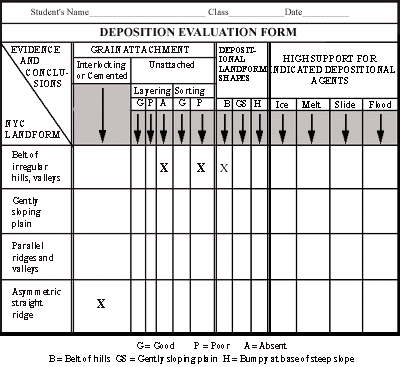EVALUATING THE PREDICTION: Each of the four major NYC landforms may now be examined to see if it displays features indicative of one or more specific depositional processes.
- To review what the NYC landforms look like, consult Landforms of NYC and the NYC Landforms Description Table and associated printout.
- To review what the landforms are made of, consult the bedrock geology map rollover and the surficial geology map rollover* and associated printouts.
*Note: On the surficial geology map rollover, if bedrock is shown as 'close to or at the surface', assume the main body of the landform is composed of bedrock and is not the result of deposition. Any loose material that locally may cover the bedrock only modifies the shape of the landform in a minor way and may be disregarded for present purposes. - To review grain attachment, consult the cohesion determination table and associated printout.
- To review grain attachment, layering and sorting of NYC materials, consult the Geologic Materials Table.
- To review features associated with specific depositional processes, consult
printout # H-4.
|
This Form (H-5) allows you to characterize the materials and shapes of each of the four major NYC landforms. In doing so, you will:
(a) be able to determine whether the landform meets the general requirement indicative of deposition (that it consists of unattached grains) and
(b) if it does consist of unattached grains, determine which specific depositional process(es) may have been involved.
(c) It also allows you to state, for each landform, how strongly supported is the prediction that its material and shape are indicative of specific agents of deposition.
The four major NYC landforms are listed in the left-hand column. Important types of observational evidence relevant to depositional origin are listed across the top-left and top-center of the checklist. These are (a) information about the grains (attachment, layering, sorting) and (b) a list of three important, characteristic depositional landform shapes. Across the top-right, four major depositional agents are listed.
- If a landform is made of attached grains (review printout Q-8) in conjunction with the surficial geology rollover ), place a mark in the first column 'interlocking or cemented'. (See filled-in NYC Landform example, 'asymmetric straight ridge'.) Attached grains means the landform is made of bedrock and therefore is NOT a result of deposition. Thus, if a mark is placed in the first column, no marks should appear in the 'layering', 'sorting', 'shape' or 'support for agent' columns because they are reserved for the characteristics of landforms made of unattached grains.
- If the landform is made of unattached grains (see partially filled-in NYC Landform example, 'belt of irregular hills, valleys'), place marks in the appropriate columns to indicate how well layered and sorted the material is. (See the legend at the bottom of the Checklist.) In the example, layering is 'absent' and 'sorting' is poor. Next, indicate whether there is a match between the actual NYC landform and one of the shapes characteristically displayed by depositional landforms (see Depositional Features Checklist, printout H-4, part 2). In the example, there is a depositional landform shape ('B') that matches the shape of the NYC landform.
- Finally, for the NYC landform in question, indicate which agent(s) of deposition are supported by both the character of the material (attachment, layering, sorting) and the 'shape match'. For any landform, support on both these counts provides high support for the prediction that 'One or more major NYC landforms will display special features indicative of specific depositional processes.' If a specific agent of deposition is supported only partially (e.g., 'layering' agrees, but 'sorting' and/or 'shape match' do not agree), do not mark its column.
PLEASE NOTE THAT THIS LAST PART OF THE EXAMPLE HAS NOT BEEN DONE FOR YOU. YOU WILL NEED TO COMPLETE THE 'belt of irregular hills, valley' EXAMPLE. |

